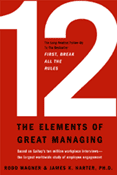I am definitely a people watcher and want to understand people better. What people like, how they think, and why they do what they do all fascinate me. I have an extremely eclectic music collection and listen to a little bit of everything because I want to understand why people like what they do. I love to watch movies for the same reason. Like a five year old kid I still have to ask the “why” question to anything and everything that I don’t understand and with the creation of Google, Wikipedia, and blogs this has only assisted in my obsession with knowledge. It’s also allowed me to be a lot less annoying in my inquires. You can find answers to anything online, let me also just state that you have to sift through a lot of crap to find real answers online if you don’t know where to look. I guess where all this randomness is going is that managing people is something that is very important, complex, and one of the most difficult skills to master. It takes a large dose of psychology, time management, respect, and business sense not to mention expertise in your industry. Currently I’m “over” an assistant and five student workers at Wofford. I say over because I really consider them much more as friends and co-workers than as their boss.

![]() is an excellent and rather easy read that presents its case in twelve very distinct chapters. Each chapter is broken down to present a different element and each presents a story of a different manager who the author has chosen to demonstrate the element. The twelve elements are as follows:
is an excellent and rather easy read that presents its case in twelve very distinct chapters. Each chapter is broken down to present a different element and each presents a story of a different manager who the author has chosen to demonstrate the element. The twelve elements are as follows:
- I know what is expected of me.
- I have the materials and equipment to do a job right.
- I have the opportunity to do what I do best every day.
- In the last week I have received recognition or praise.
- Someone at work seems to care about me.
- Someone at work encourages my development.
- My opinions seem to count.
- I am connected with the mission of my organization.
- My coworkers are committed to doing quality work.
- I have a best friend at work.
- In the last six months, someone has talked to me about my progress.
- In the last year, I have had opportunities at work to learn and grow.
As you can see each of these elements aren’t presented as things that a manager should do, but as points to make sure the manager makes clear to his or her employees. It is this difference that helps the book to make a personal connection. A manager can quickly read through a list of twelve very obvious points and think if it is things that they know about their employees or not. If not, spending the time to make the connection and engage the employee can make all the difference to them and show that you care. What is so powerful is that I think, to a lesser extent, most of these points can also be applied to consultants, project teams, and even your personal life and relationship building.
So if you are truly interesting in connecting with people better in work and even in your personal life this book is definitely a recommended read to help you “manage” and bring more meaning to these relationships.
By Founder
Book ReviewManagement